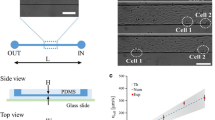Abstract
Many biologically important macromolecular reactions are assembled and catalyzed at the cell lipid-surface and thus, the extracellular matrix and the glycocalyx layer mediate transfer and exchange of reactants and products between the flowing blood and the catalytic lipid-surface. This paper presents a mathematical model of reaction–diffusion equations that simply describes the transfer process and explores its influence on surface reactivity for a prototypical pathway, the tissue factor (Tf) pathway of blood coagulation. The progressively increasing friction offered by the matrix and glycocalyx to reactants and to the product (coagulation factors X, VIIa and Xa) approaching the reactive surface is simulated and tested by solving the equations numerically with both, monotonically decreasing and constant diffusion profiles. Numerical results show that compared to isotropic transfer media, the anisotropic structure of the matrix and glycocalyx sharply decreases overall reaction rates and significantly increases the mean transit time of reactants; this implies that the anisotropy modifies the distribution of reactants. Results also show that the diffusional transfer, whether isotropic or anisotropic, influences reaction rates according to the order at which the reactants arrive at the boundary. Faster rates are observed when at least one of the reactants is homogeneously distributed before the other arrives at the boundary than when both reactants transfer simultaneously from the boundary.
Similar content being viewed by others
References
Bassingthwaighte J, Goresky C (1984) Modeling in the analysis of solute and water exchange in the microvasculature. In: Renki EM, Michael CC (eds) Handbook of physiology, the cardiovascular system, vol IV, microcirculation. William and Wilkings, Baltimore, pp 560–587
Berg O (1985) Orientations constraints in diffusion-limited macromolecular association. The role of surface diffusion as rate-enhancing mechanisms. Biophys J 47: 1–14
Berg HC (1983) Diffusion to N disk-like adsorbers on the surface of a sphere. In: Random walks in biology. Princeton University Press, Princeton, pp 30–34
Bloomfield VA, Prager S (1979) Diffusion-controlled reactions on spherical surfaces. Application to bacteriophage tail fiber attachment. Biophys J 27: 447–453
Crank J (1975) Diffusion and chemical reaction. In: Crank J (eds) In the mathematics of diffusion. Clarendon Press, Oxford, pp 326–351
Forman SD, Nemerson Y (1986) Membrane-dependent coagulation reaction is independent of the concentration of phospholipid-bound substrate: fluid phase factor X regulates the extrinsic system. Proc Nat Acad Sci USA 83(13): 4675–4679
Freskgard P, Petersen LC, Gabriel DA, Li X, Persson E (1998) Conformational stability of Factor VIIa: biophysical studies of thermal and guanidine hydrochloride-induced denaturation. Biochemistry 37: 7203–7212
Jackson CM, Hanahan DJ (1968) Studies on bovine FactorXII. Characterization of purified FactorX. Observations on some alterations in zone electrophoretic and chromatographic behavior occurring during purification. Biochemistry 7: 4506–4517
McGee MP, Chou T (2001) Surface-dependent coagulation enzymes. Flow kinetics of fX a generation on live cells membranes. J Biol Chem 276: 7827–7835
McGee MP, Teuschler H (1999) Adsorption of vitamin K-dependent proteins to live cells membranes measured under flow conditions. Thromb Haemost 82: 93–99
McGee MP, Li L, Xiong H (1992) Diffusion control in blood coagulation. Activation of FX by factors IXa/VIIa assembled on human monocyte membranes. J Biol Chem 267: 24333–24339
Nelsestuen GL, Martinez MB (1997) Steady state enzyme velocities and independent of [enzyme]: an important behavior in many membrane and particle-bound states. Biochemistry 36: 720–724
Ogston AG (1954) Methods of describing unidimensional diffusion in binary liquid systems. Trans Faraday Soc 50(12): 1303–1311
Radcliff RD, Barton PG (1973) Comparison of the molecular forms of activated bovine factor X. J Biol Chem 248: 6788–6795
Sten-Knudsen O (1978) Passive transport processes. In: Giebisch G, Tostesori DC, Ussing HH (eds) Membrane transport in biology, vol 1. Springer, Berlin, pp 5–113
Strikwerda JC (2004) Finite difference schemes and partial differential equations. Society for Industrial and Applied Mathematics, Philadelphia
Van den Berg B, Vink H, Spaan JAE (2003) The endothetial glycocalyx protects against myocardial edema. Cir Res 92: 592–594
Author information
Authors and Affiliations
Corresponding author
Rights and permissions
About this article
Cite this article
Levine, H.A., McGee, M.P. & Serna, S. Diffusion and reaction in the cell glycocalyx and the extracellular matrix. J. Math. Biol. 60, 1–26 (2010). https://doi.org/10.1007/s00285-009-0254-y
Received:
Revised:
Published:
Issue Date:
DOI: https://doi.org/10.1007/s00285-009-0254-y
Keywords
- Extracellular matrix
- Glycocalyx
- Blood-coagulation
- Tissue-factor
- Reaction–diffusion equations
- Robin boundary condition
- Finite difference scheme




